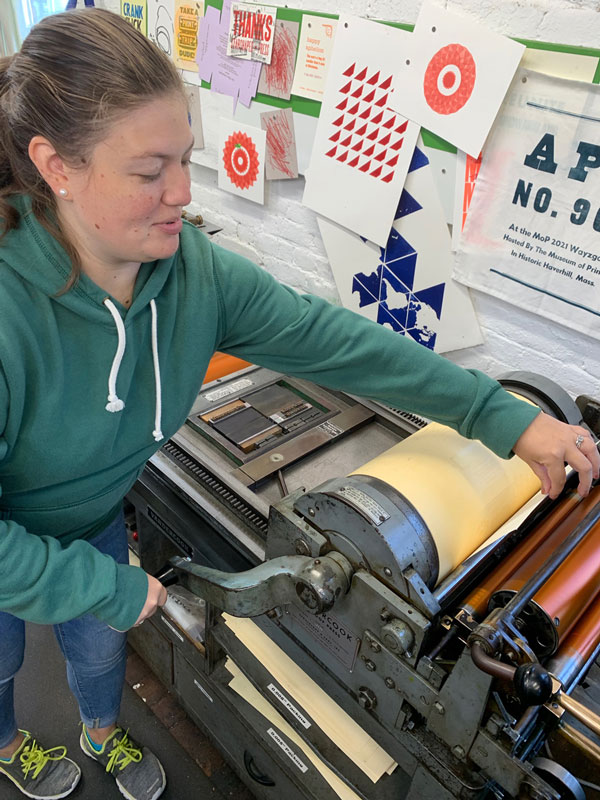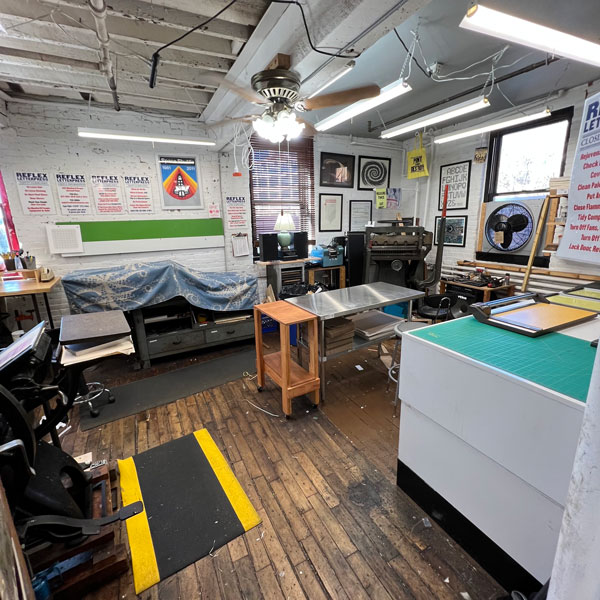One of the pieces of equipment that folks will be able to use in the studio is the 1951 Vandercook No 4 proofing press, serial number 13291, sitting in the Production Room. There is a long and amusing history behind this press, how I got it, and the people involved with it. It also serves as the story of Reflex Letterpress, when it started, and how it came about.
In 2014 I had been running the Bow & Arrow Press in the Adams House residence hall at Harvard for 6 years and had built up a large clientele of regulars, enthusiasts and students through classes and Open Press Nights.
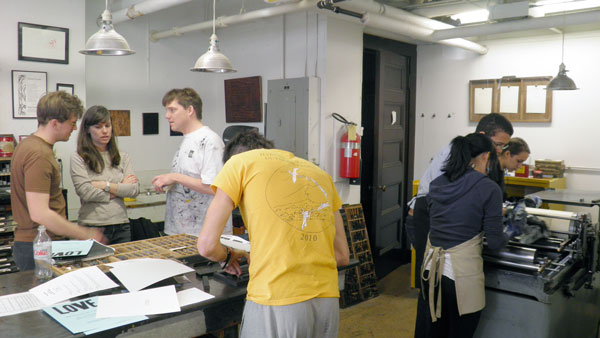
Late that fall, three of my regulars and I stumbled upon the opportunity to take over a printing studio with a Vandercook SP-20 in an old mill building in the Boston neighborhood of Charlestown. We took it over in December, and formed a print co-op called Arbalest Press. (Nota bene: an arbalest is an advanced infantry crossbow — the successor to a bow and arrow.) The SP-20 was big and heavy, but it served our needs adequately. There was one at the Bow & Arrow as well, so everyone had experience using it.
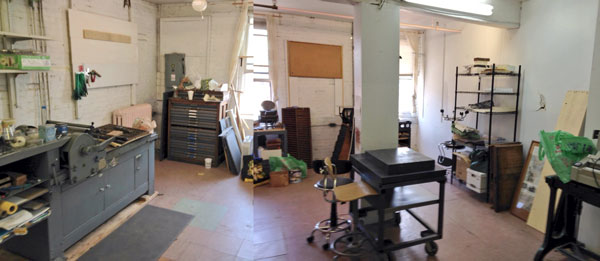
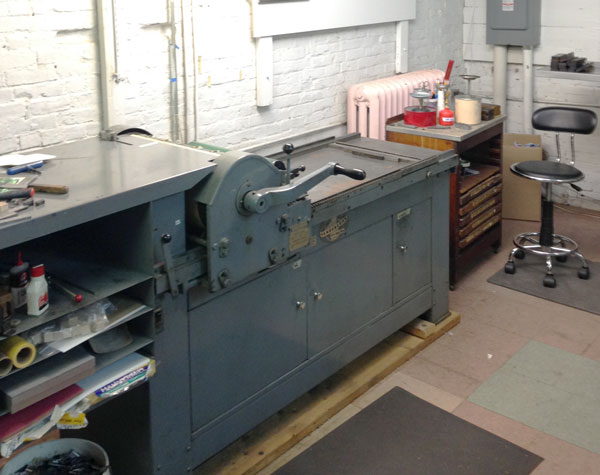
Five months later, I was preparing to teach a Crash Course at the Bow & Arrow on a Saturday morning. It had been a snowy winter and the weather had finally cleared, so I had the door open to let some fresh air in while I puttered. One of my co-op partners was setting type, and a visiting Radcliffe Scholar was figuring out the design of a broadside based on “The Red Wheelbarrow” by William Carlos Williams. Into this scene entered a dapper older gentleman. He came in hesitantly, saying that he’d been a frequent passerby of the Press over the years, and since the door was open he was enticed by the smell of printer’s ink, as he’d been a jobbing printer in the early 70s.
I welcomed him in and said to enjoy the ambiance, sniff the ink, and take a look around. He did so, checking our type collection, the tools, and the presses. Then it happened, something that you hear about in stories. Upon walking up to the Bow & Arrow’s 1950 Vandercook No 4, he looked over at me and said, “You know, I have one of these in my basement in Nahant (a town on a small peninsula to the north of Boston), would you be interested in it?”
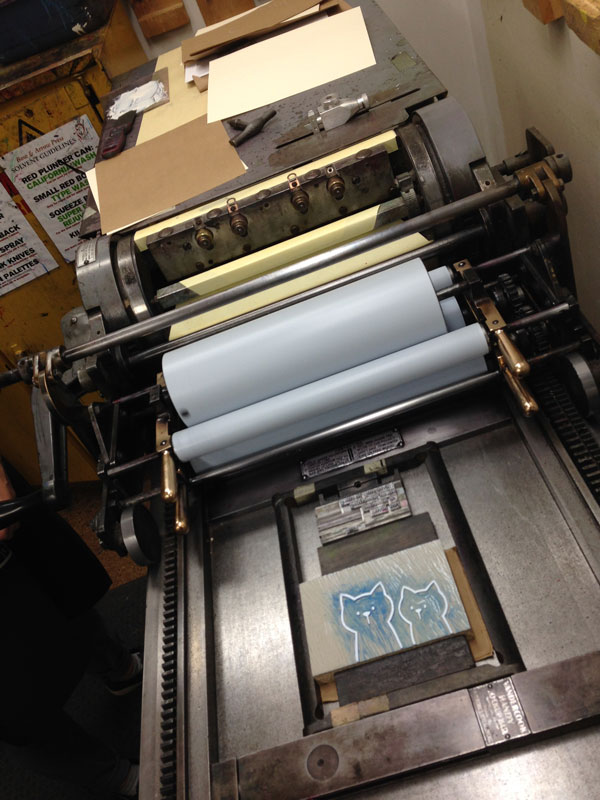
You could have heard a pin drop. My co-op partner looked at me dumbfounded, and I looked at him. The Radcliffe fellow looked highly amused at our response. The Vandercook No 4 is a coveted machine, and they are generally hard to come by, with a price to match. This was the stuff of dreams, at least to letterpress nuts. I very carefully said, “Why yes, I would very much be interested in your press, let me get your contact information.”
Long story short, the co-op purchased the press. It had been used at the Nahant newspaper but had been sold in the late 70s, and had somehow ended up in this gentleman’s basement. I was a little worried about its condition, as sitting unused in a damp basement at sea level near a body of salt water is not the best environment for anything made of steel. However, the press was covered by a canvas army tarp, and had been doused with WD-40 at some point in time. The rubber rollers had a film of dried ink on them, but otherwise were in surprisingly good shape. The mechanicals were sound, and the press ran through its printing cycle without a hitch.
My fears laid to rest, we made an offer, perhaps a little low… and he accepted immediately. Not only that, we even got some type, a Poco No 0 proof press, and a 10×15 Daughaday platen press thrown in the deal. Actually, for the price we paid, perhaps the correct term was “a steal”. He really only wanted some cash to finance restoring his little sailing skiff, and wasn’t concerned about market prices. So the deal was made.
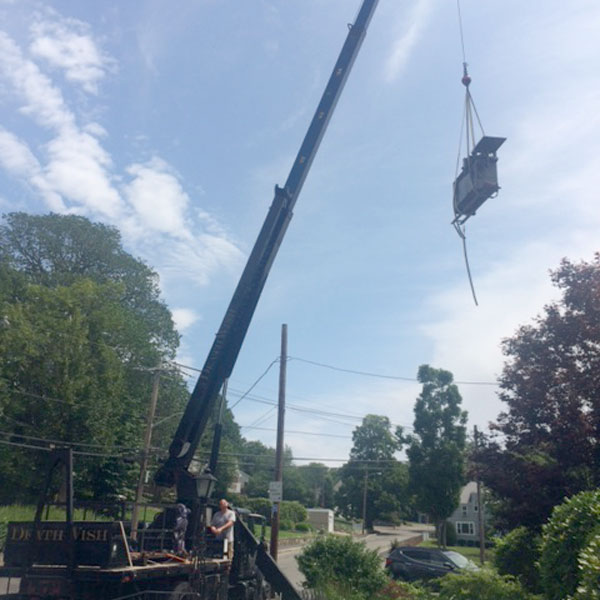
In July, riggers came, attached cables, and whisked the press out of the basement with a flatbed crane. They hauled it into Boston, set it on a dolly, loaded in the freight elevator, and bundled it into the studio. It was home. We were thrilled.
As with all old machines, it had its quirks. The cord and plug for the motor had a short and we had to replace it, the motor itself was temperamental and would sometimes refuse to turn until given a nudge, the rollers sometimes jumped off the starting block and laid an unwelcome line of ink down on the Boxcar base, and the oscillating roller frame was less of a rectangle and more of a parallelogram. But I took a class in Vandercook repair at the Museum of Printing in Haverhill with the inimitable Paul Moxon, and came back knowing enough to be dangerous. The press quickly settled in and I began cranking all sorts of things on it — invitations, birth announcements, conceptual art, esoteric greeting cards, and silly in-jokes. My partners did their own special things. It was awesome!
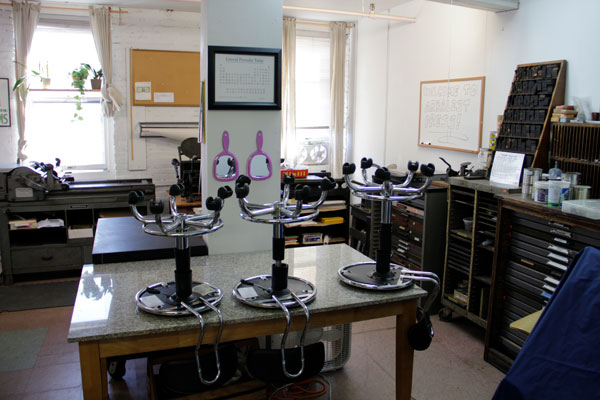
Alas. As is usual with art co-ops, Arbalest Press didn’t last very long. One of us wanted to do production, art and teaching, one of us wanted to do retail and wholesale paper goods, one of us wanted to create exquisite creations using nothing but tiny type, and one of us… well, I’m still not sure what he wanted to do… and I’m not sure he did either. All of these things were at loggerheads with each other, so after three years, it collapsed. As such things go, it was reasonably cordial, but we were still done with each other. I formed Reflex Letterpress to continue my production and teaching, moved down the hall to the former Arbalest Annex room, and I took the Nahant press with me. It was an interesting experience, rolling a 1600 lb mass of metal down an uneven wooden floor while kludged atop a precarious assembly of 2x4s, plywood, and moving dollies, but I had a friend who was expert in such things, so it got done.

It was about this time that I joined the Amalgamated Printers Association, after years of dithering. Of course, I wondered if I’d be able to make the four-piece annual minimum — but that hasn’t been a problem. During COVID I used the APA as a vehicle for safely-isolated press therapy, and haven’t done less than 18 pieces per year since. The reason I mention this is because the APA was the avenue for a final cap to the story of the Nahant press.
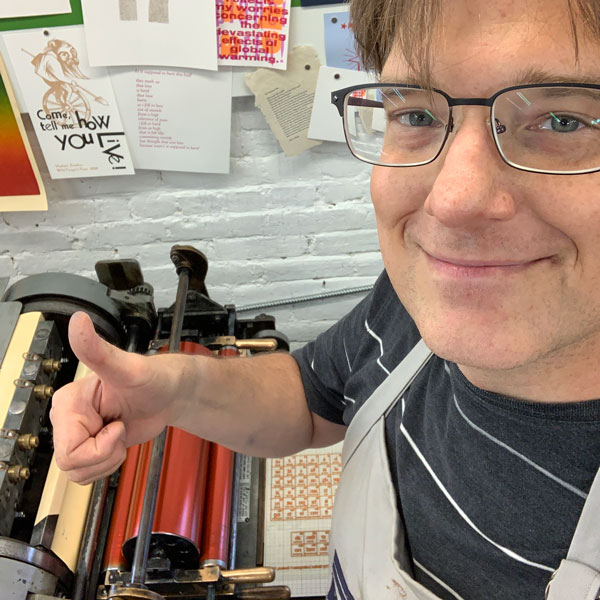
I went up to the Museum of Printing to pick up some letterpress stuff, and went into the printing room to chat with the volunteers. It turns out one of them was a fellow APA member, and had been highly amused by some of my submissions. During our conversation it came out that I was the present owner of the Nahant press, and had been instrumental in its purchase. And that’s when the kicker came.
So it seems like the deal that was a steal could actually have been construed as such, if one was of the mind to. The Nahant press had been sitting in its basement for years, and the house it was in was owned not by the gentleman who sold the press, but by his son-in-law. The son-in-law had inherited the press when he bought the property years ago, and still didn’t know what the hell he was going to do with an obsolete piece of printing machinery. Fortuitously, he mentioned to my APA colleague one day that he was thinking of scrapping it. The APA member looked aghast. He said, please don’t, I will take that press off your hands with very little effort on your part. I’ll even pay you more than the scrap value for the privilege. The son-in-law agreed, and the APA member went to find moving options for the press.
Ten days later, the son-in-law called him up, and informed him that, unbeknownst to him, his father-in-law had sold the press in the interim, and it had been whisked away earlier that week. A Vandercook No 4 for a VERY good price had slipped away in the night, and heavy was the disappointment that day.
However, all’s fair in love and printing, so the APA member didn’t hold it TOO much against me. He even bequeathed to me the lollipop roller gauge he’d taken from the press when he looked it over, although he declared it cursed. Evidently every time he’d attempted to use it to adjust the rollers on his other presses, something terrible had happened to the print job, so he was happy to see it go. So perhaps it was actually fate or divine intervention that had prevented him from taking ownership of the Nahant press. I will say, I’ve never had a problem with any demonic visitations from using that roller gauge.
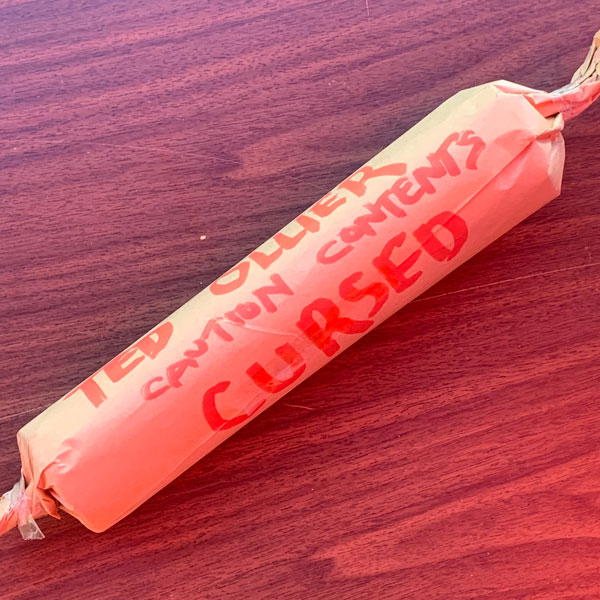
So the Nahant press has been happily living on the west wall of my studio for the last five years. In those years, I have grown Reflex into a DIY wedding shop, teaching press, and letterpress rental center. All through that time the Nahant press has been solid and dependable, and I can make it sing, dance, and choreograph musical numbers. In March of 2022 I took a risk and got it a friend, a 1948 Vandercook No 4 from Tulsa, and in October of 2022 I expanded into a second studio space. The Nahant press is now considered the Production Press, but that means that experienced printers are using it to create handmade items, delight clients, and make a good amount of money on the side. A fitting occupation for a long veteran of the letterpress business.
